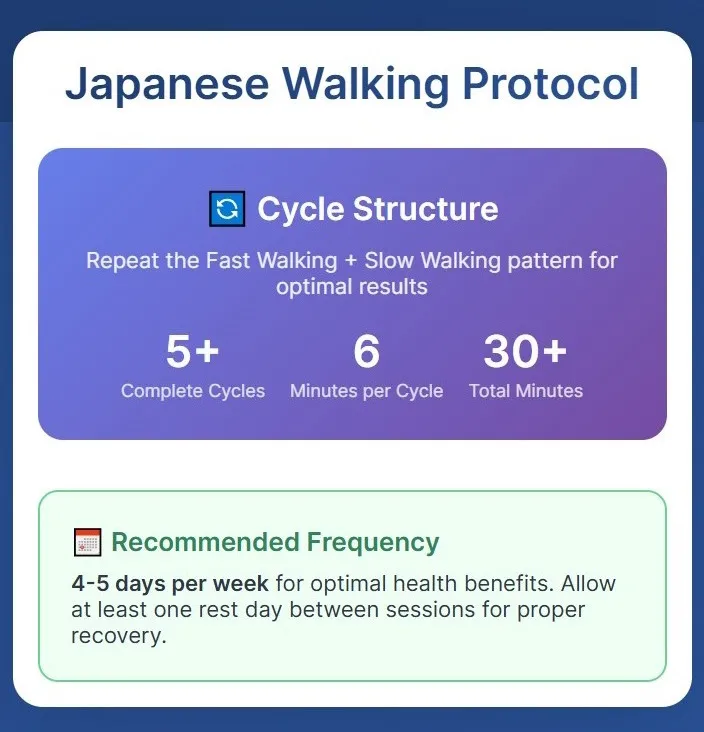How to Start Interval Walking Training: A Complete Beginner's Guide
Starting Interval Walking Training: Your Complete Beginner's Guide

Ready to try interval walking for beginners but not sure where to begin? Don't worry – IWT is designed to be beginner-friendly. This guide will walk you through everything you need to know to start safely and successfully.
Before You Begin: The Essential Prep
What You Actually Need
The beauty of IWT is its simplicity. Here's your complete equipment list:
- Good walking shoes (the most important investment)
- A timer or smartphone (for tracking intervals)
- Comfortable clothes (nothing fancy required)
- Water bottle (stay hydrated!)
Shoe note: Don't underestimate the importance of proper footwear. During fast intervals, you'll be putting more stress on your feet and joints than during casual walking. Supportive shoes can prevent discomfort and injury.
Should You See a Doctor First?
If you're generally healthy and can walk comfortably for 30 minutes, you're probably fine to start IWT. However, you should definitely consult your doctor first if you have:
- Heart conditions or chest pain
- High blood pressure that's not well-controlled
- Diabetes (especially if you have complications)
- Recent injuries or joint problems
- Any condition that affects your ability to exercise safely
When in doubt, ask: It's always better to get medical clearance than to risk injury. Most doctors will appreciate that you're taking a thoughtful approach to starting an exercise program. For comprehensive safety guidelines, check our complete safety guide.
The IWT Protocol: Step by Step
Your First Session Blueprint

Here's exactly how to structure your first IWT session:
| Phase | Duration | Intensity (RPE) | Talk Test | VO2peak % |
|---|---|---|---|---|
| Warm-up | 3-5 minutes | Light | Comfortable conversation | N/A |
| Fast Walking | 3 minutes | 6-7/10 ("Somewhat Hard") | Can speak a few words, but full conversation difficult | ≥70% |
| Slow Walking | 3 minutes | 3-4/10 ("Light") | Comfortable conversation | ~40% |
| Cool-down | 3-5 minutes | Light | Comfortable conversation | N/A |
Session Structure: Repeat Fast/Slow cycles 5+ times (30+ minutes total) • Frequency: 4-5 days per week
Breaking It Down Further:
Warm-up (3-5 minutes)
- Start with easy, comfortable walking
- This isn't optional – it prepares your body for the work ahead
- You should feel relaxed and ready to pick up the pace
The Main Event: Fast/Slow Cycles
-
Fast walking (3 minutes)
- Pace: Brisk but not breathless
- Talk test: You can say a few words but can't hold a full conversation
- Rate of effort: 6-7 out of 10 ("somewhat hard")
-
Slow walking (3 minutes)
- Pace: Comfortable and conversational
- Talk test: You can easily chat with a friend
- Rate of effort: 3-4 out of 10 ("light")
-
Repeat this cycle 5 times (total of 30 minutes)
Cool-down (3-5 minutes)
- Return to easy walking
- Let your heart rate gradually return to normal
- Take a moment to feel proud of what you just accomplished!
Intensity reality check: During fast intervals, you should feel like you're walking with purpose – maybe like you're late for an important meeting – but you shouldn't feel like you're about to collapse.
Understanding Your Effort Level

The RPE Scale (Rate of Perceived Exertion)
- 1-2: Very easy (sitting on the couch)
- 3-4: Light activity (slow walking, can sing)
- 5-6: Moderate (can talk easily)
- 6-7: Somewhat hard (can talk but it takes effort) ← Fast intervals
- 8-9: Hard (can only say a few words)
- 10: Maximum effort
The Talk Test Simplified
- Slow intervals: You could easily have a phone conversation
- Fast intervals: You could answer questions but wouldn't want to chat for long
Pro tip: If you're exercising with a friend, you'll naturally use the talk test. During slow intervals, you'll chat easily. During fast intervals, the conversation will naturally pause or become brief exchanges.
Your Progressive Training Plan

Week 1-2: Getting Started
Goal: Learn the rhythm and build the habit
- Duration: Start with just 3 cycles (18 minutes total) plus warm-up and cool-down
- Frequency: 4 days per week (try Monday, Wednesday, Friday, Saturday)
- Focus: Getting comfortable with the intensity changes and using your timer
Beginner tip: Don't worry about perfect timing or intensity in your first few sessions. Focus on getting the feel for alternating between faster and slower walking.
Week 3-4: Building Endurance
Goal: Work up to the full protocol
- Duration: Increase to 4-5 cycles (24-30 minutes total)
- Frequency: 4-5 days per week
- Focus: Maintaining consistent intensity during fast intervals
Week 5+: Adding Challenge
Goal: Continue progressing and prevent plateaus
Options for advancement:
- Extend sessions: Add 1-2 more cycles
- Add inclines: Find hills or use a treadmill incline
- Increase intensity: Push the fast intervals to 7-8 out of 10 effort
- Add variety: Try different routes or surfaces
Progression principle: Only add one challenge at a time. If you increase duration, keep the intensity the same until you adapt. If you add hills, maybe stick with the standard 5 cycles until that feels manageable.
Practical Tips That Actually Work
Timing Made Easy
- Use a simple interval timer app (many are free)
- Set it to repeat: 3 minutes fast, 3 minutes slow, repeat
- Start the timer when you begin your first fast interval (after warm-up)
For those interested in optimizing their timing setup, our technology and tracking guide covers everything from basic interval walking training timer options to advanced monitoring systems.
Japanese Interval Walking Timer Setup
Many successful practitioners use these simple approaches:
- Smartphone timer apps with custom intervals
- Basic alternating alarms every 3 minutes
- Voice announcements for hands-free operation
Common Beginner Mistakes (and How to Avoid Them)
Mistake 1: Going too hard too fast
- Solution: It's better to feel like you could do more than to exhaust yourself early on
Mistake 2: Not warming up
- Solution: Always start with 3-5 minutes of easy walking. Your future self will thank you.
Mistake 3: Perfect timing obsession
- Solution: Being a few seconds off isn't going to ruin your workout. Focus on the effort level, not the exact second.
Mistake 4: Skipping the cool-down
- Solution: Those final few minutes of easy walking help your body transition back to rest mode.
Tracking Your Progress
Simple Ways to Monitor Improvement
- Keep a basic log: Date, duration, how it felt (1-10)
- Note improvements: "Could talk more easily during fast parts today"
- Track consistency: Aim for your planned number of sessions per week
- Celebrate small wins: Completing your first full 30-minute session is a big deal!
Progress isn't always linear: Some days will feel easier, others harder. That's completely normal and doesn't mean you're not improving.
When to Increase the Challenge
- You can complete 5 cycles without excessive fatigue
- The current intensity feels easier than when you started
- You're hitting your sessions consistently
- You genuinely feel ready for more challenge
Troubleshooting Common Issues
"I can't maintain the fast pace for 3 full minutes"
- Start with 2-minute intervals and gradually increase
- Make sure you're not going too fast – it should be brisk, not a race
"I'm getting side stitches"
- Slow down during fast intervals
- Make sure you're not eating too close to your workout
- Focus on steady breathing
"This feels too easy"
- Make sure you're actually hitting 6-7 out of 10 effort during fast intervals
- Consider adding inclines or extending your session
"I keep forgetting to do it"
- Schedule it like an appointment
- Link it to an existing habit (e.g., "After my morning coffee, I do IWT")
- Find an accountability buddy
For comprehensive solutions to these and many other common challenges, check our complete FAQ and troubleshooting guide.
The Bottom Line
Starting IWT doesn't require perfection – it requires consistency. Focus on showing up regularly and gradually building the habit. The intensity will come naturally as you get more comfortable with the protocol.
Remember, even the researchers who developed IWT started with small steps. Every expert was once a beginner, and every successful IWT practitioner had a first day just like the one you're about to have.
Once you've been doing IWT for a few weeks, you might start wondering how it compares to other popular fitness approaches. Our detailed analysis of IWT vs. the famous 10,000 steps goal shows which approach delivers better results in less time.
New to the concept of Interval Walking Training entirely? Start with our introduction to what IWT actually is to understand the foundation before diving into the practical implementation.
Comments
Post a Comment